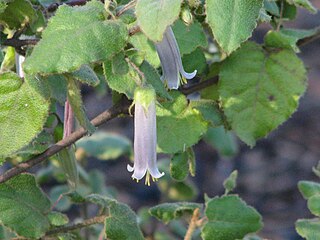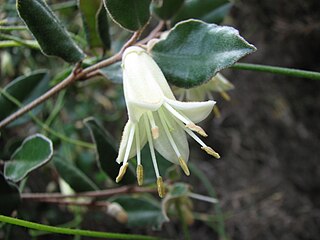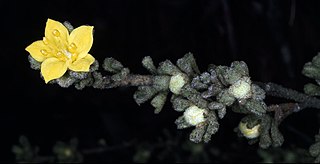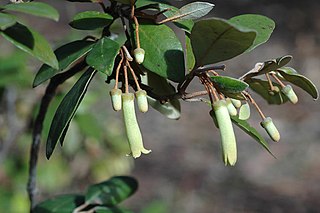
Correa is a genus of eleven species of flowering plants in the family Rutaceae that are endemic to Australia. Plants in the genus Correa are shrubs to small trees with simple leaves arranged in opposite pairs, bisexual flowers with four sepals, four petals usually fused for most of their length and eight stamens.

Correa alba, commonly known as white correa, is a species of shrub that is endemic to south-eastern Australia. It has egg-shaped to more or less circular leaves, erect white flowers arranged singly or in groups on short side branches, and green fruit.

Correa lawrenceana, commonly known as mountain correa, is a species of shrub or small tree of the family Rutaceae and is endemic to Australia. It has elliptical to egg-shaped leaves arranged in opposite pairs and cylindrical, greenish yellow to red flowers usually arranged singly or in groups of up to seven in leaf axils with the stamens protruding beyond the end of the corolla.

Correa calycina, commonly known as the South Australian green correa or Hindmarsh correa, is a species of tall, dense shrub that is endemic to a small area of South Australia. It has papery, oblong leaves and pendulous green flowers arranged singly on the ends of short side branches.

Correa aemula, commonly known as the hairy correa, is a species of shrub that is endemic to south-eastern Australia. It has broadly heart-shaped leaves arranged in opposite pairs, green or greyish green, pendent flowers arranged singly or in pairs and ageing to mauve-purple.

Correa backhouseana is a species of rounded shrub that is endemic to coastal and near-coastal areas of southern Australia. It has elliptical to egg-shaped or round leaves that are densely hairy on the lower surface, and cylindrical to funnel-shaped, cream-coloured to pale green or red and yellow flowers.

Correa decumbens, commonly known as the spreading correa, is a species of prostrate to spreading shrub that is endemic to South Australia. It has narrow oblong to narrow elliptical leaves and narrow cylindrical, pink to red flowers with green lobes.
Correa eburnea, commonly known as the Deep Creek correa, is a species of shrub that is endemic to the Fleurieu Peninsula in South Australia. It has papery, elliptic to egg-shaped leaves, and up to five green, nodding flowers arranged in leaf axils.

Pomaderris paniculosa, commonly known as scurfy pomaderris, is a species of flowering plant in the family Rhamnaceae and is native to Australia and New Zealand. It is a shrub with hairy branchlets, round to elliptic or egg-shaped leaves with the narrower end towards the base and panicles of hairy, cream-coloured to greenish, sometimes crimson-tinged flowers.
Nematolepis frondosa, commonly known as leafy nematolepis, is a shrub that is endemic to Victoria, Australia. It is a small, conical shaped shrub with glossy leaves, scaly branchlets and white flowers in winter and spring.

Asterolasia phebalioides, commonly known as downy starbush, is a species of shrub in the family Rutaceae and is endemic to south-eastern continental Australia. It has densely crowded heart-shaped to wedge-shaped leaves densely covered with star-shaped hairs, and single yellow flowers borne on the ends of branchlets with star-shaped hairs on the back of the petals.

Correa lawrenceana var. cordifolia, commonly known as the pink mountain-correa, is a variety of Correa lawrenceana and is endemic to south-eastern Australia. It is a shrub with leathery, broadly egg-shaped to heart-shaped leaves, and pink flowers with yellowish tips arranged singly or in groups of two or three in leaf axils.
Correa lawrenceana var. genoensis, commonly known as the Genoa River correa, is a variety of Correa lawrenceana and is endemic to south-eastern Australia. It is a shrub with egg-shaped leaves and yellowish green flowers usually arranged singly in leaf axils.

Correa lawrenceana var. glandulifera, commonly known as the mountain correa, is a variety of Correa lawrenceana and is endemic to eastern Australia. It is a shrub or small tree with egg-shaped leaves and greenish yellow flowers arranged singly or in groups of up to five with woolly hairs on the outside.

Correa lawrenceana var. latrobeana is a variety of Correa lawrenceana that is endemic to south-eastern Australia. It is a shrub or small tree with elliptical to egg-shaped leaves and cylindrical, greenish-yellow or reddish-mauve flowers arranged singly or in groups of up to seven in leaf axils or on the ends of branchlets.

Correa lawrenceana var. lawrenceana is the implicit autonym of Correa lawrenceana and is endemic to Tasmania. It is a shrub with papery, oblong leaves and pale green, narrow cylindrical flowers arranged singly on the ends of branchlets.
Correa lawrenceana var. macrocalyx is a variety of Correa lawrenceana and is endemic to New South Wales. It is a shrub with leathery, egg-shaped to broadly egg-shaped leaves, and cylindrical, greenish yellow flowers arranged in leaf axils or on the ends of short branchlets.
Correa lawrenceana var. rosea is a variety of Correa lawrenceana that is endemic to the Snowy Mountains of New South Wales. It is a shrub with narrow elliptical leaves and narrow cylindrical flowers that are pink or dull red with green lobes and covered with small, compact star-shaped hairs.

Pomaderris pallida, commonly known as pale pomaderris, is a species of flowering plant in the family Rhamnaceae and is endemic to the south-east of continental Australia. It is a compact, rounded shrub with hairy stems, narrowly elliptic to narrowly oblong leaves and panicles of cream-coloured flowers.
Pomaderris precaria is a species of flowering plant in the family Rhamnaceae and is endemic to New South Wales. It is a slender shrub with hairy new growth, elliptic to lance-shaped leaves with the narrower end towards the base, and panicles of cream-coloured flowers.














